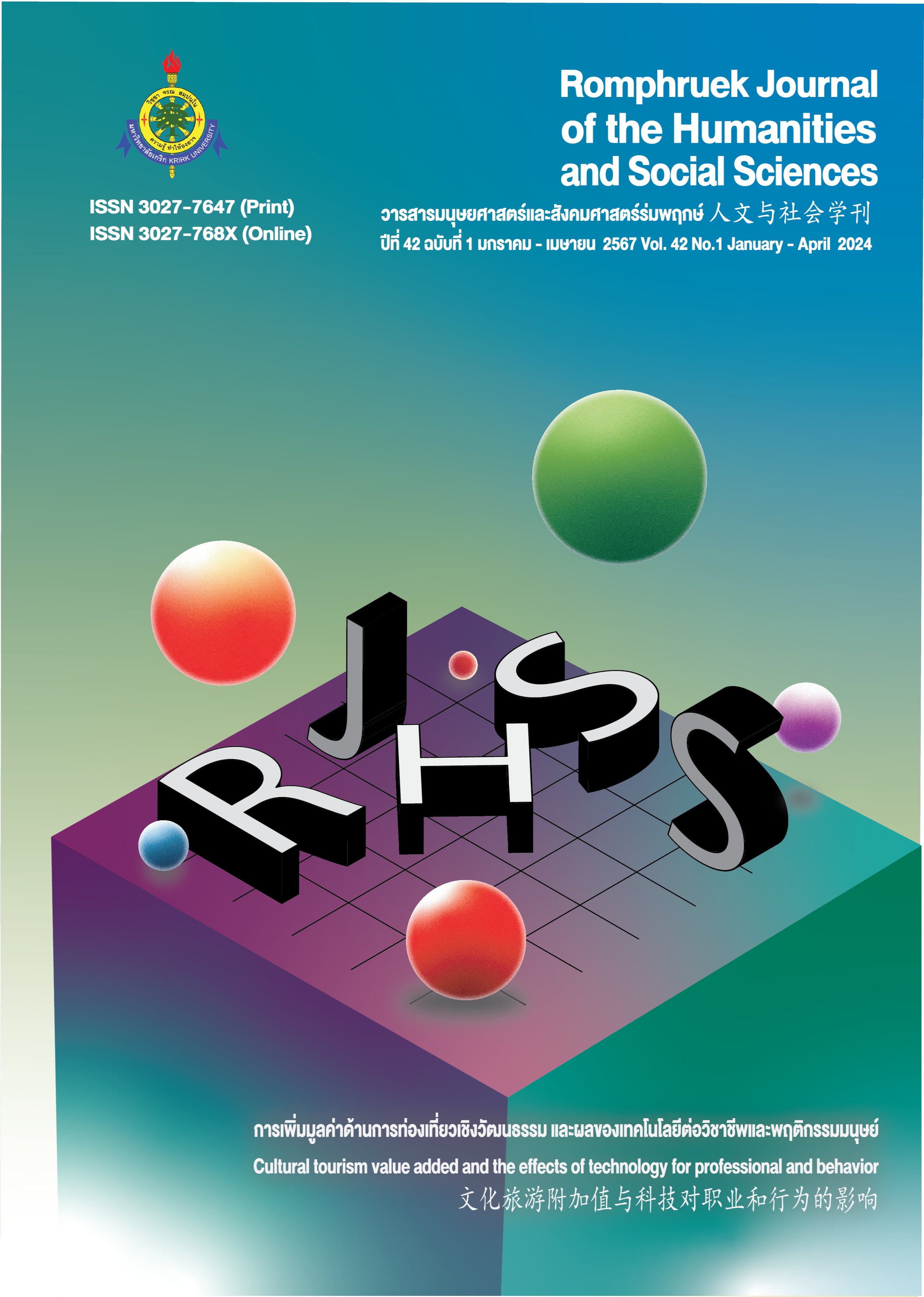An Analysis Of Tourism Potential And Situations Analysis of Community – Based Tourism Bang Sakae Subdistrict, Bangkhonthi District Samutsongkhram Province
Main Article Content
Abstract
The purpose of this research was to to examine the state of community-based tourism and its potential in Bang Sakae Subdistrict, Bang Khonthi District, Samut Songkhram Province. This study employs a qualitative methodology that includes document studies, interviews, non-participant observation, and SWOT analysis (SWOT Analysis). The research’s findings showed that Bang Sakae Subdistrict, Bang Khonthi District, Samut Songkhram Province was ready to be a model for community-based tourism.
The results of the research were as follows:
In terms of the community strengths, strong community leaders who focus on human resource development and steer work in the same direction were among the community's assets. In addition, it had a caring social structure and well-managed community. There were good community capital and well-defined community rules and regulations. The interactions between the locals and tourists were positive. It was also a community where property and life were safe. Individuals in the community, which included a sizable youth organization, worked together on environmental issues. In addition, a comprehensive management system for benefit sharing and revenue distribution was established by the community.
One of the community's weakness was its location, which was farther from the city and thus increased manufacturing expenses. However, due to the community's aging population, there weren't enough people to support the workforce, for example, when the coconut packing house contaminated the shallow waterways (Lam Pradong), In terms of tourism operations, there were too many trade monopolies in the area, which prevented a wide range of operations in the tourism sector. Because the community was an old one, it lacked younger members to lead tourism-related activities as well as the effectiveness of passing on tourism-related knowledge to the younger generation. Furthermore, a few community members disregarded the laws and guidelines.
In terms of opportunities, Bang Sakae Sub-district had external partners to support, to make study visits and to participate in many activities. The neighborhood included an attractive scenery, easy access to transit, and effective communication systems. There were bus services that came and went from the neighborhood. Besides, there were community funds, including external and internal funding sources that supported CBT activities. The neighborhood contained educational facilities as well. Furthermore, the government sectors established policies aimed at continuously promoting tourism and gave greater consideration to the planning of tourist-related events within the community.
Regarding the community threats, it was discovered that there was still a lack of public space for organizing activities, processing goods and promoting careers. In addition, the neighborhood was a small sub-district that frequently experienced storm-related natural disasters as well as the effects of climate change. As a result, the product prices were decline. Moreover, because they had to contribute to their own accomplishments, the local government agencies lacked integration. Furthermore, a multitude of causes, including the Covid-19 pandemic, political unrest, and economic difficulties, have contributed to the decline in tourism since 2020.
In conclusion, the result revealed that the community had covered all 6 components of tourism and was ready to be developed by community-based tourism.
Article Details

This work is licensed under a Creative Commons Attribution-NonCommercial-NoDerivatives 4.0 International License.
Every article published in the Romphruek Journal of the Humanities and Social Sciences is the opinion and point of view of the authors. Thery're not the viewpoint of Krirk University or the editored department. Any part or all of the articles for pablication must be clearly cited.
References
กระทรวงการท่องเที่ยวและกีฬา(2565, 23 ธันวาคม).สถิติการท่องเที่ยวประเทศไทย ปี 2565. https://www.mots.go.th.
กองเศรษฐกิจการท่องเที่ยวและกีฬา สำนักงานปลัดกระทรวงการท่องเที่ยวและกีฬา. (2565). รายงานภาวะเศรษฐกิจการท่องเที่ยว (พิมพ์ครั้งที่ 1). กระทรวงการท่องเที่ยวและกีฬา.
ธนพล จันทร์เรืองฤทธิ์.(2562).แนวทางการจัดการการท่องเที่ยวโดยชุมชนเพื่อการท่องเที่ยวอย่างยั่งยืน กรณีศึกษา ชุมชนริมน้ำ จันทบูร อำเภอเมือง จังหวัดจันทบุรี (วิทยานิพนธ์ปริญญามหาบัณฑิต ไม่ได้ตีพิมพ์). มหาวิทยาลัยกรุงเทพ.
ธง คำเกิด พลารัก ไชยโย เพียงฤทัย เสงี่ยมศิลป์ จิตราภรณ์ เถรวัตร อุทมพร เรืองฤทธิ์ และ พรทิพย์ ช่วยเพล (2563). การพัฒนาการท่องเที่ยวเชิงเกษตรชุมชนโดยองค์กรแบบพหุภาคี ชุมชนวังยาง จังหวัดสุพรรณบุรี. วารสารวิจัยเพื่อการพัฒนาเชิงพื้นที่, 12(6), 432-450.
พจนา สวนศรี. (2546). คู่มือการจัดการท่องเที่ยวโดยชุมชน (พิมพ์ครั้งที่ 1). โครงการท่องเที่ยวเพื่อชีวิตและธรรมชาติ.
พจนา สวนศรี และสมภพ ยี่จอหอ. (2556). คู่มือมาตรฐานการท่องเที่ยวดดยชุมชน. หจก.วนิดาการพิมพ์
พัชรีรัต หารไชย. (2552). การประเมินศักยภาพด้านการท่องเที่ยวจังหวัดศรีสะเกษเพื่อการกำหนด แนวนโยบายการท่องเที่ยวอย่างยั่งยืนระดับจังหวัด. (วิทยานิพนธ์ปริญญามหาบัณฑิต ไม่ได้ตีพิมพ์). มหาวิทยาลัยสถาบันเทคโนโลยีพระจอมเกล้าเจ้าคุณทหารลาดกระบัง.
ณัฏฐพัชร มณีโรจน์. (2560). การจัดการการท่องเที่ยวโดยชุมชน. วารสารวิชาการการท่องเที่ยวไทยนานาชาติ, 13(2), 25-46.
วีระพล ทองมา และประเจต อำนาจ. (2547). ผลที่เกิดขึ้นจากการจัดกิจกรรมการท่องเที่ยวต่อประชาชนในพื้นที่ตำบลแม่แรม อำเภอแม่ริม จังหวัดเชียงใหม่. (วิทยานิพนธ์ปริญญามหาบัณฑิต ไม่ได้ตีพิมพ์). มหาวิทยาลัยแม่โจ้.
Pike, S. D. (2008). Destination Marketing: an integrated marketing communication approach. Butterworth-Heinemann.
Shirley, E. (1993). Beyond the Green Horizon: Principles for Sustainable Tourism. World Wide Fund for Nature.
United Nations World Tourism Organization. (2020, December 25). CHANGES IN TRAVELLER BEHAVIOUR IN TIMES OF COVID-19. https://www.unwto.org/covid-19-and-tourism-2020.
Walters, G., Huck, L., Robinson, R. N. S., and Stettler, J. (2021). "Commercial hospitality in tourism: A global comparison of what culturally matters. International Journal of Hospitality Management, 95(2021), 102-939. doi:10.1016/j.ijhm. 2021.102939.


